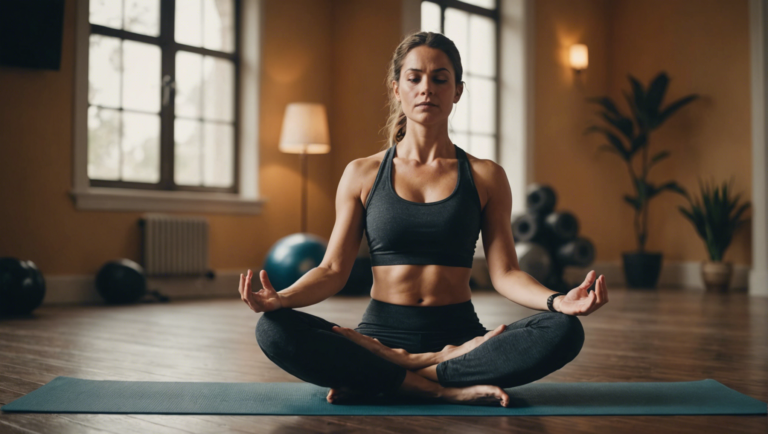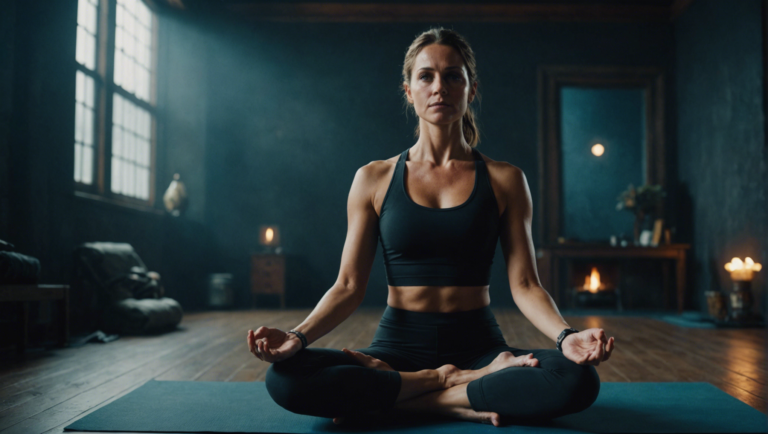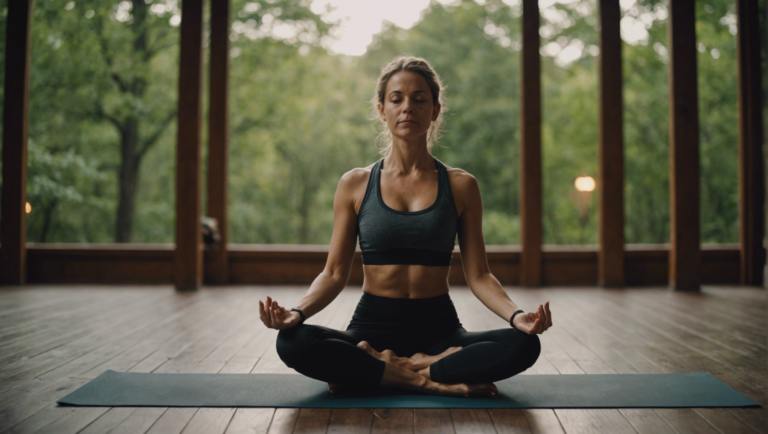Guidelines For Safely Jumping Back In Yoga Practice
Importance of Easing Back into Yoga Practice Safely
Yoga is a holistic practice that offers a multitude of physical, mental, and emotional benefits. Many individuals turn to yoga to enhance flexibility, reduce stress, and improve overall well-being. However, after an extended break from their practice, it is crucial to approach the return to yoga with caution to prevent injuries and promote a smooth transition back into regular practice.
Understanding the Importance of Easing Back into Yoga
Returning to yoga after a hiatus requires a gradual and mindful approach. It is essential to understand that the body may have lost some of its flexibility, strength, and endurance during the break. Jumping back into intense yoga sessions without proper preparation can lead to strains, sprains, or other injuries. Therefore, easing back into yoga practice safely is paramount to reap the full benefits of the practice.
Guidelines for Safely Jumping Back in Yoga Practice
-
Assess Your Current Fitness Level: Before resuming your yoga practice, take the time to assess your current fitness level. Start with gentle movements and stretches to gauge your flexibility and strength. Listen to your body and avoid pushing yourself beyond your limits.
-
Start Slowly: Begin with shorter yoga sessions or classes to allow your body to reacclimate to the practice. Focus on basic poses and gradually increase the intensity and duration of your practice over time.
-
Modify Poses as Needed: If you encounter difficulty with certain poses due to decreased flexibility or strength, don’t hesitate to modify them. Use props such as blocks, straps, or bolsters to support your body and prevent strain.
-
Focus on Breath Awareness: Pay attention to your breath throughout your practice. Deep, conscious breathing not only enhances the benefits of yoga but also helps prevent injuries by promoting mindfulness and body awareness.
-
Stay Hydrated and Well-Nourished: Proper hydration and nutrition are essential when reinitiating your yoga practice. Drink an adequate amount of water and consume nutritious foods to support your body’s needs during this transition.
-
Listen to Your Body: One of the most crucial aspects of easing back into yoga practice is listening to your body. If you experience pain or discomfort during a pose, back off and reassess. Pushing through pain can lead to injuries and setbacks in your practice.
-
Consult with a Yoga Instructor: If you are unsure about how to safely resume your yoga practice, consider consulting with a qualified yoga instructor. They can provide guidance, modifications, and personalized recommendations based on your individual needs and abilities.
Returning to yoga after a break is an opportunity to reconnect with your body, mind, and spirit. By following these guidelines and approaching your practice with patience and mindfulness, you can safely ease back into yoga and experience the manifold benefits it has to offer. Remember, the journey back to your mat is a personal one, so honor your body’s needs and progress at your own pace.
Common Mistakes to Avoid When Restarting Yoga Practice
Starting a yoga practice after a break can be exciting, but it’s essential to approach it mindfully to avoid common mistakes that may hinder progress or cause injury. By understanding these pitfalls, you can ensure a smooth and safe return to your yoga practice.
Ignoring Physical Limitations
One of the most common mistakes when restarting a yoga practice is ignoring your body’s limitations. It’s crucial to listen to your body and respect its current abilities. Pushing yourself too hard too soon can lead to injuries or burnout. Instead, start slowly, gradually increasing the intensity and duration of your practice as your strength and flexibility improve.
Skipping Warm-Up and Cool Down
Another mistake many people make when restarting yoga is skipping the warm-up and cool down phases of their practice. Warm-up exercises help prepare your body for the main practice by increasing blood flow to your muscles and joints. Cool down exercises are essential for winding down and preventing stiffness or soreness after your practice.
Not Using Proper Form
Maintaining proper form is key to reaping the full benefits of yoga and preventing injuries. When restarting your practice, pay attention to your alignment during each pose. Focus on engaging the right muscles and avoid overarching or straining your body to achieve a pose. If you’re unsure about your form, consider attending a beginner’s class or working with a qualified yoga instructor.
Pushing Too Hard for Progress
Yoga is a journey that requires patience and consistency. It’s common to want to progress quickly after restarting your practice, but pushing yourself too hard can lead to setbacks. Remember that yoga is not just about achieving advanced poses but also about connecting with your breath and body. Honor where you are in your practice and celebrate the small victories along the way.
Comparing Yourself to Others
One of the pitfalls of restarting yoga practice is comparing yourself to others in the class or on social media. Remember that everyone’s body is unique, and progress looks different for each individual. Focus on your own journey and growth rather than trying to emulate someone else’s practice. Embrace your strengths and work on areas that need improvement with self-compassion.
Neglecting the Mind-Body Connection
Yoga is not just a physical practice; it also involves cultivating a strong mind-body connection. When restarting your yoga practice, take the time to check in with yourself mentally and emotionally. Use the practice as a moving meditation, focusing on being present on the mat and letting go of external distractions.
By avoiding these common mistakes when restarting your yoga practice, you can make the most of your return to the mat. Remember to listen to your body, prioritize proper form, and approach your practice with patience and self-compassion. With consistency and mindfulness, you can build a strong foundation for your yoga journey and enjoy the many benefits it offers.
Tips for Gradually Increasing Flexibility and Strength in Yoga
Yoga is a fantastic way to improve flexibility and strength, providing numerous physical and mental benefits. As you progress in your yoga practice, gradually increasing your flexibility and strength is essential to prevent injuries and enhance your overall well-being. Here are some practical tips to help you achieve this effectively.
Consistent Practice Leads to Progress
Consistency is key when it comes to increasing flexibility and strength in yoga. Regular practice allows your body to adapt to the various poses and movements, gradually improving your flexibility and strength over time. Aim to practice yoga at least a few times a week to see positive results in your flexibility and strength levels.
Focus on Proper Alignment
Focusing on proper alignment in each yoga pose is crucial for both safety and effectiveness. Aligning your body correctly not only helps prevent injuries but also ensures that you are engaging the right muscles to improve strength and flexibility. Paying attention to your alignment during practice will also deepen your poses and allow you to progress further.
Incorporate Dynamic Stretching
Dynamic stretching involves moving parts of your body and gradually increasing reach and speed of movement. This type of stretching is beneficial for warming up your muscles before a yoga session, as it helps improve flexibility and range of motion. Including dynamic stretching exercises in your yoga routine can help prepare your body for more challenging poses, leading to increased flexibility and strength.
Gradually Increase Intensity
As you become more comfortable with your yoga practice, gradually increase the intensity of your sessions to build strength and flexibility. You can do this by holding poses for longer periods, trying more advanced variations of poses, or incorporating props to deepen stretches. By challenging yourself slightly in each practice, you can push your limits safely and see improvements in your flexibility and strength.
Listen to Your Body
One of the most important aspects of yoga practice is listening to your body. Pay attention to how your body feels during each session and honor its limitations. Pushing yourself too hard or forcing your body into poses beyond its capabilities can lead to injuries and setbacks. By practicing mindfulness and tuning in to your body’s needs, you can progress safely and effectively in your yoga journey.
Stay Hydrated and Nourished
Proper hydration and nutrition play a significant role in improving flexibility and strength in yoga. Drinking an adequate amount of water throughout the day helps keep your muscles hydrated and flexible. Additionally, fueling your body with nutrient-dense foods will provide the energy needed for your yoga practice, enhancing your overall performance and progress.
Gradually increasing flexibility and strength in yoga requires dedication, patience, and mindful practice. By following these tips and staying committed to your yoga journey, you can experience growth both physically and mentally, leading to a healthier and more vibrant life.
Understanding the Mind-Body Connection in Yoga Practice
In the world of yoga, the mind-body connection plays a crucial role in enhancing one’s practice and overall well-being. Understanding how the mind and body interact during yoga sessions can deepen your practice and amplify the benefits that yoga has to offer.
Importance of Mind-Body Connection in Yoga Practice
The mind-body connection in yoga is the link between your physical body and mental state. It involves being fully present in the moment, focusing on your breath, and listening to your body’s needs. When you synchronize your breath with movement in yoga, you engage both your mind and body, creating a harmonious connection that can lead to a greater sense of inner peace and balance.
Enhancing Awareness Through Breath and Movement
One of the key elements of the mind-body connection in yoga is the emphasis on breath awareness. By focusing on the breath during yoga practice, you can calm the mind, increase oxygen flow to the muscles, and cultivate a sense of mindfulness. This allows you to stay present in each moment and move through postures with intention and awareness, deepening the mind-body connection.
Listening to Your Body’s Signals
Yoga encourages practitioners to listen to their bodies and honor their physical limitations. The mind-body connection in yoga involves tuning in to the signals that your body sends you during practice. Whether it’s a sensation of tightness, discomfort, or ease, being attuned to these signals can help you adjust your practice to suit your body’s needs, preventing injuries and promoting self-care.
Cultivating Emotional Balance and Mental Clarity
Through the mind-body connection in yoga, practitioners can cultivate emotional balance and mental clarity. When you are present in the moment and focused on your breath and movement, you can quiet the chatter of the mind and cultivate a sense of inner peace. This can help reduce stress, anxiety, and promote overall mental well-being.
Strengthening the Mind-Body Connection Off the Mat
The mind-body connection cultivated during yoga practice can extend beyond the mat and into daily life. By incorporating mindfulness, breath awareness, and body listening into your everyday routine, you can stay grounded, reduce stress, and enhance your overall quality of life. The skills learned on the yoga mat can be applied off the mat, allowing you to navigate challenges with grace and resilience.
Embracing the Journey of Self-Discovery
Ultimately, the mind-body connection in yoga is a journey of self-discovery and self-awareness. By deepening your understanding of how your mind and body interact, you can explore your inner landscape, uncovering hidden truths, and embracing your authentic self. This journey of self-discovery is transformative and can lead to profound personal growth and empowerment.
The mind-body connection in yoga is a profound and transformative practice that can enhance not only your physical health but also your mental, emotional, and spiritual well-being. By cultivating a strong mind-body connection through breath awareness, body listening, and mindfulness, you can deepen your yoga practice and enrich your life both on and off the mat.
Incorporating Mindfulness and Breathing Techniques for a Safe Yoga Return
Yoga practitioners are often eager to jump back into their practice after a hiatus, whether due to a busy schedule, illness, or any other reasons. However, returning to yoga with mindfulness and proper breathing techniques is key to ensuring a safe and effective practice. By incorporating these elements into your routine, you can not only prevent injuries but also deepen your mind-body connection and overall experience on the mat.
Importance of Mindfulness in Yoga Practice
Mindfulness plays a crucial role in yoga practice as it allows individuals to focus on the present moment, cultivate self-awareness, and connect with their bodies on a deeper level. When returning to yoga after a break, it’s important to approach your practice with a beginner’s mind, free from expectations or judgments. Pay attention to how your body feels, honor its limitations, and let go of any ego-driven desires to push yourself too hard.
Breathing Techniques for a Safe Return
Breath is the foundation of a yoga practice, serving as a bridge between the mind and body. Utilizing proper breathing techniques can help calm the mind, reduce stress, and enhance the flow of energy throughout the body. When restarting your yoga practice, focus on deep diaphragmatic breathing, also known as "belly breathing." This type of breathing not only provides stability during poses but also helps prevent injuries by promoting relaxation and reducing tension in the body.
Tips for Safely Resuming Yoga Practice
-
Listen to Your Body: Pay attention to any discomfort or pain during your practice. It’s essential to distinguish between sensations that indicate progress and those that signal potential injury.
-
Start Slowly: Don’t push yourself too hard in the beginning. Start with gentle sequences and gradually increase the intensity and duration of your practice as your body adjusts.
-
Modify Poses: If you’re not able to perform certain poses as you did before, don’t force yourself into them. Use props or modifications to support your practice and prevent strain.
-
Stay Hydrated: Proper hydration is essential for a successful yoga practice. Drink an adequate amount of water before and after your session to stay hydrated and maintain energy levels.
-
Warm-Up and Cool Down: Always incorporate a proper warm-up and cool down into your practice to prepare your body for movement and prevent injuries.
Mindfulness and breathing techniques into your yoga practice is not only beneficial for your physical well-being but also for your mental and emotional health. By approaching your practice with awareness, patience, and self-compassion, you can navigate your return to yoga safely and enjoyably. Remember that yoga is a personal journey, and it’s essential to honor your body’s needs and limitations along the way. By prioritizing safety and mindfulness, you can make the most out of your practice and experience its transformative benefits fully.
Conclusion
Mindfulness and breathing techniques as part of a safe return to yoga practice is essential for a holistic experience. These techniques not only help in reducing stress and anxiety but also aid in improving focus and concentration during your practice. Mindfulness encourages you to stay present in the moment, allowing you to listen to your body’s signals and avoid overexertion. Deep breathing techniques, such as ujjayi pranayama, can help in oxygenating the body and calming the mind, creating a harmonious flow during your practice.
When restarting your yoga journey, understanding the mind-body connection is paramount. Yoga is not just a physical practice; it involves mental and emotional aspects as well. By acknowledging and honoring this connection, you can deepen your practice and enhance overall well-being. Listen to your body cues, be compassionate with yourself, and embrace the journey with a positive mindset. Remember, progress in yoga is not just about achieving advanced poses but about the inner transformation and growth that occurs along the way.
Tips for gradually increasing flexibility and strength in yoga are crucial for a safe and sustainable practice. It’s important to start slowly, respecting your body’s current limitations, and gradually progressing as your flexibility and strength improve. a balanced mix of stretching, strengthening, and balancing poses in your practice can help prevent injuries and enhance overall physical fitness. Patience and consistency are key in building a strong foundation for long-term yoga practice.
Common mistakes to avoid when restarting your yoga practice include pushing yourself too hard, neglecting proper alignment, and comparing yourself to others. Remember that yoga is a personal journey, and each individual’s progress is unique. Avoiding ego-driven attitudes and focusing on your personal growth can help you stay grounded and avoid unnecessary injuries. By practicing self-awareness and self-compassion, you can cultivate a safe and nurturing environment for your yoga practice.
Easing back into yoga practice safely is of utmost importance for both beginners and experienced practitioners. Whether you’re returning after a hiatus or recovering from an injury, taking a gradual approach will help you build strength, flexibility, and mindfulness without overwhelming your body. By following these guidelines and honoring your body’s needs, you can embark on a fulfilling and sustainable yoga journey that nourishes both your physical and mental well-being.
Restarting your yoga practice is a rewarding opportunity to reconnect with your body, mind, and spirit. By prioritizing safety, mindfulness, and gradual progression, you can lay a strong foundation for a fulfilling and sustainable practice. Remember that yoga is a personal journey of self-discovery and growth, so embrace each step of the process with patience, compassion, and dedication. May your return to yoga be filled with joy, peace, and a deep sense of inner connection.


